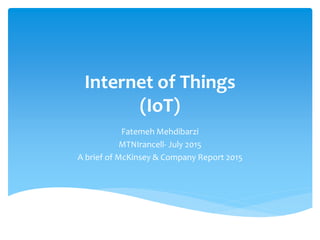Internet of Things (IoT)
- 1. Internet of Things (IoT) Fatemeh Mehdibarzi MTNIrancell- July 2015 A brief of McKinsey & Company Report 2015
- 2. ïŠ linking the physical world to the Internet and other data networks ïŠ monitoring and managing operations thousands of miles away, tracking goods as they cross the ocean, or detecting changes in the blood pressure of a diabetic that might be a sign of a heart attack ïŠ redefining how we engage with the physical world and making possible computer-mediated ways of doing business, managing public infrastructure, and organizing peopleâs lives IoT Features
- 3. HUMAN ïŠ two broad categories: ïImproving health ïRaising productivity HOME ïŠ energy management ïŠ Security ïŠ automation of domestic chores IoT Value creation
- 4. RETAIL ENVIRONMENTS ïŠ online shopping OFFICES ïŠ principally managing energy and security systems by excluding commercial spaces FACTORIES ïŠ predictive maintenance ïŠ inventory optimization WORKSITES ïŠ oil and gas exploration and production, mining, and construction (most advanced user of IoT) e.g. heavily instrumented equipment and advanced robotics on board, often connected to a real-time command center half a world away
- 5. VEHICLES ïŠ IoT sensors and connectivity can improve how vehicles are serviced, maintained, and designed CITIES ïŠ improve services, relieve traffic congestion, conserve water and energy, and improve quality of life OUTSIDE ïŠ Outdoors between urban environments, such as in vehicular navigation, container shipping, and package delivery ïŠ condition-based maintenance of rail lines and other transportation infrastructure
- 6. ïŠ having certain technologies, organizational capabilities, and policies in place ïŠ collaboration among supplier companies and among suppliers, users, and policy makers to set the standards and protocols for the interoperability of IoT systems that maximize value ENABLERS AND BARRIERS
- 7. ïŠ Software and hardware technology ïŠ Interoperability ïŠ Intellectual property, security, privacy and confidentiality ïŠ Business organization and culture ïŠ Public policy Types of Enablers
- 8. Thank You
Editor's Notes
- #4: Using IoT systems to convince healthy people to change their living habits and to help sick patients adhere to doctorsâ prescriptions would be a true breakthrough.
- #5: Predictive maintenance involves using sensors to monitor machinery continuously to avoid breakdowns and determine when maintenance will be required, rather than relying on regularly scheduled maintenance routines. IoT can improve inventory management by automatically restocking parts bins based on weight or height data recorded by sensor
- #8: Five types of enablers are needed for maximum IoT impact SOURCE: McKinsey Global Institute analysis Software and hardware technology ⊠Low-power, inexpensive sensors and computers ⊠Ubiquitous connectivity/low-cost mesh connectivity ⊠Additional capacity and bandwidth in the cloud ⊠Confidence in security across entire IoT ecosystem Interoperability ⊠Standardization in the technology stack and ability to integrate across technology vendors ⊠Standard protocols for sharing between IoT systems ⊠Standard access to external data sources Intellectual property, security, privacy, and confidentiality ⊠Establishing trust with consumers for sharing data ⊠Collaboration across companies and industry verticals ⊠Horizontal data aggregators ⊠Data commerce platforms Business organization and culture ⊠Industry structure, e.g., organized labor cooperation, third-party servicing ⊠Hardware-focused companies developing core competency in software ⊠Companies committing to up-front investment based on clear business cases Public policy ⊠Regulation for autonomous control of vehicles and other machinery ⊠Government and payer subsidy of health-care IoT ⊠Agreements on fair practices for data sharing and use








